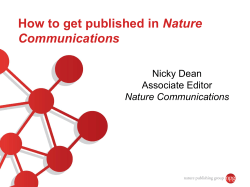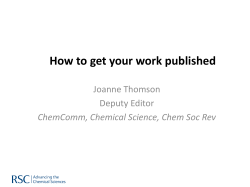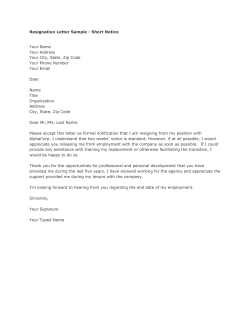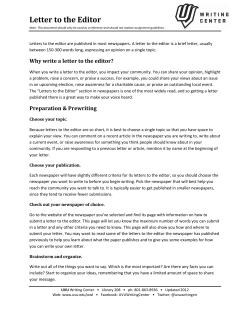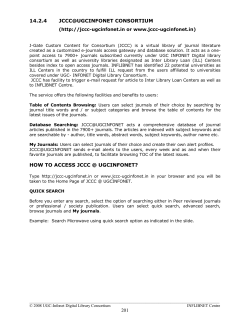
How to Publish At the June, 2008 CEA meetings, the Canadian Women Economists Network and the Canadian
How to Publish At the June, 2008 CEA meetings, the Canadian Women Economists Network and the Canadian Economics Association jointly sponsored a session on “How to Publish”. Jen Baggs spoke on publishing against the tenure clock. Dwayne Benjamin gave the Canadian Journal of Economics editor’s perspective. Joyce Jacobsen, editor of the Eastern Economics Journal, talked about common mistakes and how to avoid them. And Lynda Khalaf shared her experiences of publishing theoretical econometrics. A short summary of the talks and the general discussion follows. Publishing Against the Tenure Clock Jen Baggs, University of Victoria Let me start with the caveats that (1) I do not actually have tenure, though I will apply in the coming year, and (2) as these comments are based solely on my own opinion and experiences, their generalizability to a broader population is unconfirmed. Writing good quality papers is a necessary condition for success in publishing but it is not by itself a sufficient condition, particularly when faced with the time pressures of a tenure clock. Excellent papers need to be paired with good logistical management and strategic decisions. My remarks will focus on these organizational aspects of publishing against the tenure clock. The time from your initial manuscript submission to acceptance, in the absolute best case scenario, is at least one year. If you have rejections, multiple revise and resubmits, or any other hiccups, it will be longer. In my experience the average time from initial submission to acceptance is closer to two years, and sometimes it takes much longer. The first chapter of my thesis was initially submitted in early 2003, and was not accepted until May 2008. When you consider this in the context of a five year tenure clock (package submitted at the beginning of your 6th year), this means that to be on the safe side, everything you want counted as a publication on your tenure application pretty much has to be in submission form by the end of your third year in that job. I would encourage everyone starting a new job to set “five submissions by end of third year” as a goal. Because time is so much of the essence, I would also suggest that you act strategically about where you chose to send your papers. Some points to consider: 1. Balance quality and volume. If you have one or two papers you want to aim high with, do so. Send them to good journals, even if it is a long shot. Be ambitious, but balance that ambition with some safer bets. Since the probability of acceptance declines as journal quality rises, ambitious submissions are more likely to end up going through more than one journal, or to have more than one revision, before they are published. Make some pragmatic choices to ensure that there is something on your CV at the end of the day. 2. Know what your department values. Make sure that the people who will be looking at your tenure case value the journals you submit to. More or less everyone likes the AER, but the further you get from the very top journals, the more variation there is in how people view the quality of a journal. Find out the relative value of different journals in your field and in your department and use this information strategically. In my case, being in a business school, it is very important to have at least one publication in a Financial Times Top 40 journal. There are, however, only four economics journals on this list: American Economic Review, Journal of Political Economy, Econometrica and RAND. I did not have a paper that could realistically hit at any one of these journals, but I did have something that, with slight re‐writing, could be sent to the Journal of International Business Studies, also on the FT top 40 list. This paper was accepted, and for my tenure case, this publication viewed as more or less equivalent to something in American Economic Review and is worth more to me than, say, a publication in… the Quarterly Journal of Economics. 3. Avoid craziness at all costs. Inquire with colleagues about the reputation of a journal for things like: turn around time, strange editorial policies, probability of your manuscript getting lost, disputes with publishers, long backlogs, missing editors, etc. If you have a reasonable suspicion of any craziness, do not send your paper there. As you may have guessed, I learned this the hard way. The aforementioned paper submitted in 2003 and accepted in 2008 took so long to be published mostly because of time spent languishing at a poorly managed journal. If you have not had a response to your submission in more than six months, do consider an extremely polite inquiry with the editor (or better yet, editorial assistant). Be polite but persistent until you get a response. 4. Read the fine print. Once you’ve chosen your journal, make sure your submission meets their guidelines. Do not exceed the page limit, if they want the tables separated from the text at the end of the paper, put them at the end, if they only want pdf files, send a pdf file… and so on. Read also the fine print of your own paper; make sure your references are up to date and correct, check the spelling, if you struggle with language, hire an English editor before you submit….be careful and thorough in all things. Once you get a response, continue to think strategically and use your time well: 1. Send rejections back out quickly. Do not be discouraged! Be pragmatic. Have a look at the referee reports, fix anything serious, and send it back out right away. If a referee makes a good suggestion, particularly one which is easy to implement – do it. This will improve the paper and appease the referee should you happen to get the same one on your second submission (not impossible!). Do not, however, spend too much time fixing small esoteric things, as next time you will likely get a different referee with different ideas. Do not give up on a paper after one (or two…) rejections. Once you have incurred the sunk cost of writing the paper, make a good attempt to get it published. 2. Consider carefully if a revise and resubmit is “do‐able”. If a revise and resubmit is negative in tone, and you are seriously concerned you may not be able to satisfy one or more referees, carefully consider whether or not to undertake the revision. Get advice from senior colleagues. A correspondence with the editor regarding what you think you can or can not do in terms of completing a revision, and their guidance as to whether this will be satisfactory before you do all the work, could be of tremendous value. 3. Ask for advice, but do so judiciously. If you have a paper without a senior co‐author, make use of the experience and guidance of senior colleagues or former supervisors if you can. Ask the most specific and focused question possible. Perhaps ask for advice addressing a specific comment from a referee, or editor. Ask someone to read your “response to reviewers” or “letter to editor”, or a particular section of your paper (perhaps the introduction) when you are finished your revision. If you ask for something small(er) it is more likely that you will get a quick and specific response, which will be focused on what you need the most help with. 4. Send your revision back expeditiously, but be meticulous. My supervisor gave me the excellent advice that you should always work on the paper that is the closest to publication first. So if you get a revise and resubmit, it should get priority in your work load. Try to turn it around within a few months if at all possible. This should not, however, be at the expense of thoroughness. Your revision should be absolutely meticulous: respond to each and every point very carefully, try to leave the reviewers no avenue for objection. 5. Good luck! Maximizing the Probability of Publication: Tips from the CJE Dwayne Benjamin, University of Toronto When talking about how to publish, it is difficult to avoid sounding like Monty Python’s lesson on how to play the flute. “Well here we are. You blow there and you move your fingers up and down here.” Accurate but unhelpful. So I will begin with the elements of a good paper: a good idea (contribution) and sound execution. If it’s worth doing, it’s worth doing well ‐ But note the corollary: If it’s NOT worth doing, … Glenn Ellison’s 2002 JPE article on “Evolving Standards for Academic Publishing: A q‐r Theory” argues that papers are now judged less by the quality of their main ideas and more by other dimensions of quality –the execution of the idea. The first objective for anyone getting published is to avoid rejection. So try not to irritate referees and/or the editor. Don’t make rejection the obvious recommendation by submitting a difficult to read paper with poor writing ‐ or by making exaggerated claims, major errors of execution, providing incomplete and out of date citations, or half‐baked execution. Self‐plagiarizing (or environmentally sound publishing – ‘reduce, reuse, recycle’) is not acceptable. Attention to detail matters. And it’s more feasible to get the details right than to come up with a great idea. It’s about signaling the competence of the author, as much as establishing the case for your paper. The literature review is an important part of the paper, and something people often struggle with. Provide up‐to‐date literature citations. Do NOT do a detailed literature review, however. Place your paper in the literature and relate your findings to the most important existing papers. Explain how the paper differs from others of your own. The literature review can help guide in choice of referees. Strive for good, clear and honest writing. A good introduction that sets out the contribution of the paper is worth the effort. Discuss endogeneity issues and caveats, even if they cannot be fixed – aim for transparency. Your paper should be easy to read, and written in clear English. One common mistake is not to discuss clearly what is in the tables. Avoid long papers! Aim for 20 to 25 pages plus a half dozen tables. The CJE will publish online appendices – take advantage of this opportunity. Glenn Ellison’s 2002 JPE article on “The Slowdown of the Academic Publishing Process” estimates than one additional page delays the refereeing process by 5 days. If you receive a revise and resubmit – do it, and don’t take forever. Until I became CJE editor, I did not realize that most revise and resubmits are, eventually, published. So revise, and write a detailed explanation of how you addressed all concerns and comments, also explain any other changes. Cursory revisions are a sure way to irritate editors and referees. One more thing: There is a payoff to refereeing. It’s an easy way of finding out what other people in your field are doing, and making a positive impression on editors . Especially with respect to the CJE, the Canadian economics community is small, and your personal reputation matters. Publishing: Common Mistakes and How to Avoid Them Joyce Jacobsen, Wesleyan University and Editor, Eastern Economics Journal First of all, some “don’ts” – pitfalls to avoid if you hope to have a successful academic career: 1. Taking too long to get stuff out It can take two or three years to go from initial submission of a manuscript at a journal to publication. You can reduce the time‐to‐publication by cutting down the time to initial submission, the turnaround time when you get a revise and resubmit, and the turnaround time when you get a reject in sending to another journal. (You should already have in your mind a list of journals to work your way down) 2. Having too few papers Aim for minimum publishing units, and get more than one paper out of your dissertation. Most early papers are too long. Short papers have a better chance of getting a faster turnaround (easier to find referees for them) and of being accepted, or of being accepted with less revision requested. 3. Not diversifying your publication portfolio It would be good to have a mix of article types: both single‐author and co‐author (better to publish with a peer than with an advisor; having more than one co‐author is not an additionally positive signal); preferably something in a top generalist journal, a second‐tier generalist journal, a top specialist journal, and a more policy‐oriented or interdisciplinary journal (this latter category is more important later in one’s career). A good later career stage diversification can be writing a book, writing a textbook, or editing (or coediting) a book. 4. Not keeping the pipeline full. In steady state you should have at least • one new submission under consideration, • one revise and resubmit that you’re working on, • one revise and resubmit at a journal, • and two new papers—one by yourself, one with a coauthor—that you’re working on. For your new papers, establish clear deadlines as to when they will be working papers ready to circulate—and force yourself to finish by submitting conference abstracts. Also keep an eye out for grant applications and sabbatical applications; don’t forego internal funding opportunities 5. Watch out for organizing your “spare” time inefficiently. Don’t develop new time‐consuming hobbies ‐ ‐ this includes spending too much time on household tasks, like cooking, laundering, and cleaning the house. Use your economist training to do home tasks efficiently, including behavioral economics findings; be organized. Outsource nonessential household chores, including routine childcare (e.g., carpool, use daycare). Don’t let non‐office time be a dead zone. One approach is to work nights during the week but take off weekends; another approach is to work on either Saturday or Sunday but take the other day off. Carry work with you at all times to take advantage of dead time, especially if you have to take children to practices and other events. Reading manuscripts, routine grading, having a notepad to jot down ideas, doing university administrative tasks are all portable tasks. And don’t get picky about when and where you can work. Break down research into doable parts; have tasks that you can do in short periods of time rather than insisting on long uninterrupted periods of time. And some “do’s” – positive steps to take for academic success: 1. Any task worth doing is worth doing with the mininum effort needed to get the job done. Avoid lengthy internal memos, or writing too many comments on student papers. Keep templates for everything, including course syllabi and letters of recommendation. 2. Logroll/network Provide supply as well as demand – so write referee reports for journals (but don’t spend too long on them). You never know when it will pay off. If you really don’t have time or don’t feel qualified to do it, turn down a referee request politely and quickly and suggest an alternative referee if at all possible. The same is true for being a discussant at a conference. You never know which contacts will pay off, so make lots of them. Go to conferences and meet people Finally, if you’re not willing to put the time into your career, think carefully about whether the straight academic life is the right career for you. You have to be self‐directed and organized to be a successful academic researcher. There are rewarding research‐oriented career opportunities in government, consulting firms and NGOs. However it turns out, remember that you entered this profession for a reason—you wanted to be an economist. Find the job that allows you the best chance for success in your career. Marketing Theoretical Econometrics Lynda Khalaf Carleton University, GREEN, and CIREQ This talk is based on my experience. So I will not claim any generality, nor “unbiasedness”, nor “consistency”, nor “robustness”, nor “normality” for that matter, and I will not attempt to control errors of any “Type”. This being said, the purpose of this talk is to share a few tips/recommendations I have found extremely helpful in my career. 1. Find the correct balance between your own interests and current general interest in the profession. You can be successful, even if you do not follow fashion. Marcel Dagenais once said to me, describing his research interests, “I am not sure I am in fashion [Je ne suis pas sur d’être à la mode].” At the same time, if your research or methods are not in line the current "hot" interests in the profession, you can expect to receive letters from the editor along these lines: “Your paper has refreshingly interesting results; nevertheless, your submission does not make a contribution of the sort expected of....”. The key is to find a balance that works for you. 2. Read within and between the lines of editor and referee reports, deal with rejections, mean, unfair and wrong reports, and identify opportunities. Take advantage of any opportunities editors give you – as my colleague Jean‐Thomas Bernard said, describing his editorial relationships. “When an editor opens the door a crack, I tend to push my foot through [Quand un éditeur entrouvre une porte, j’enfonce mon pied]”. However sometimes you have to let things go: “Nothing can be done against stupidity [Il n’y a rien à faire contre la stupidité]”. (Source will remain unnamed, given the delicate nature of the advice.) 3. Decide whether you are a GP or a specialist. An econometrician can be thought of as a data doctor, and econometrics as a service discipline. Many papers I have published were born when colleagues knocked on my door with a good question. At the same time, while diversification works, too much “dispersion” will hurt the “significance” or impact of your research. 4. Identify where your work fits on the theory/empirical scale: a. Pure Theory b. Theory + Interesting Application c. Challenging Empirical Problem + Innovation on Theory d. Pure Empirical 5. Writing and style will make you or break you. A paper is not a collection of theorems, even in econometrics. We are still a social science. Sometimes what is considered to be good writing is a matter of taste. For example, I have received comments along these lines ‐ Referee I: “This paper is very well written”; Referee II: “This paper is poorly written”. But at the same time, if someone says to you, as my supervisor Jean‐Marie Dufour said of a paragraph in the first version of my thesis “I am a coauthor, and if I cannot understand what we are saying here, this is not a good sign [Je suis co‐auteur, et si je ne comprends pas ce que nous racontons ici, ce n’est pas bon signe”] – you know you have work to do. Writing and style, 3 commandments I. Notation, Notation, Notation. This means having a good framework section: reader should not get sea‐ sick turning pages back & forth, and providing a complete statistical definition for what you are estimating (or testing). Terms like “correlation”, “steady‐state”, “trend”, “volatility” are not definitions. Instruments sets, lag choices, simulation design, bootstrap recipes, DO NOT BELONG IN FOOTNOTES. Unless you are a pure theorist, supplement your theorems with guidelines, algorithms and discussion of practical implications. II. The Story‐telling “Introduction.” You need a punch Line and key‐buzz words [“Man‐Bites‐Dog” rather than “Dog‐Bites‐Man” approach yet “no over‐sell”]. Set out the contributions of your paper. III. The “My Method Works” conclusion. Identify the competition, and show that your methods work relative to available ones. Explain why we infer that your method works from one empirical exercise. Your simulation design needs to be linked to a realistic setting, but remain clear and repeatable. Conclusion My description of a successful publication “path”: though random walks may occasionally lead to random successes, the process requires high persistence, minimal drifts, is stable yet allows for structural change. Discussion Frances Woolley, Carleton University One of the themes that came through in almost every talk was the importance of good writing. But how do you learn to write well? One thing that many in the audience were surprised to learn is that it is fine to hire someone to copyedit your work and fix the grammar and spelling mistakes. Some resources for improving your writing: • Take advantage of all of the services your university offers, for example, writing tutorial services, career development services, and so on. Your university is making a major investment in you – they want you to succeed. Don’t be ashamed to ask for help. • Hiring a professional copyeditor may cost less than you think –and it’s worth paying something in order to get tenure ‐ there is a listing of professional copyeditors at http://www.editors.ca/hire/ode/index.html. • Ask around – one of the department’s administrative staff, for example, might have a degree in English and an interest in Economics and be willing to earn a little extra cash. • And speak, read and write in English as often as you can. Reading children’s stories, like Dr. Seuss, out loud, is a great way for getting a feel for the rhythm of the English language. Another frequently asked question was “how do I know how journals rank?” As Jen Baggs stressed in her talk, what matters for your tenure decision is how your department ranks particular journals. But there are a number of journal rankings out there, for example: • Yolanda K. Kodrzycki and Pingkang Yu (2006) “New Approaches to Ranking Economics Journals” The B.E. Journal of Economic Analysis and Policy • Pantelis Kalaitzidakis, Theofanis P. Mamuneas and Thanasis Stengos (2003) “Rankings of Academic Journals and Institutions In Economics” Journal of the European Economic Association http://www.bm.ust.hk/econ/JEEA.Ranking.pdf also http://www.le.ac.uk/economics/research/rankings/econ‐rankings.html • Web of Science (Social Sciences Citation Index) – log in through your university library. Measures of the impact of your own research can also be important (they made a difference in my own tenure decision – FW). Web of Science, Google Scholar (scholar.google.com) and Ideas (ideas.repec.org) all provide measures of the citation impact of your work.
© Copyright 2025

